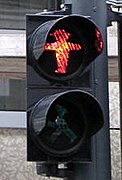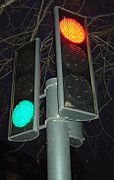Phantom light
Phantom light or phantom lights is an effect in lighting technology that occurs when a light signal is illuminated by an external light source (usually sunlight ), making it appear as if the signal is lighting up , when in fact it is not. This false indication conveys an unwanted signal meaning to the viewer.
In road and rail traffic in particular, the incorrect display of light signals represents a considerable potential risk. For this reason, various measures are taken to prevent or at least effectively reduce phantom light.
Emergence
The appearance of phantom light can be caused in different ways:
- The rays of the sun hit the disk of the light signal and are reflected back from there. The viewer recognizes that the pane surface lights up slightly.
- The rays of the sun hit the reflector inside the signal chamber and collect there at the focal point. Then they are reflected by the glass bulb or the filament and thrown back to the viewer. In this case it looks like the light source is switched on.
- The rays of the sun hit the reflector in the signal chamber and are reflected back to the viewer.
Countermeasures
Over time, various measures have been developed to avoid the creation of phantom light:
- Shielding screens shade the light signal and prevent sunlight from entering the signal chamber.
- Use of signal lights without reflector in the signal chamber.
- Installation of a lamella insert behind the pane. The incident sunlight is absorbed by the black slats.
- Use of LED signals, as these allow (almost) no reflection due to the design.


